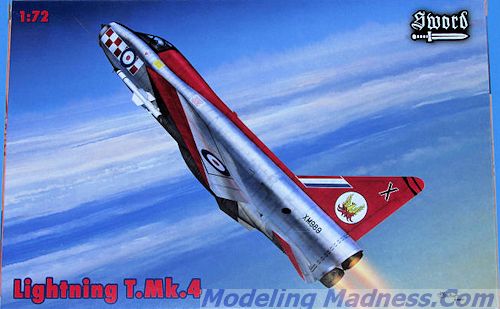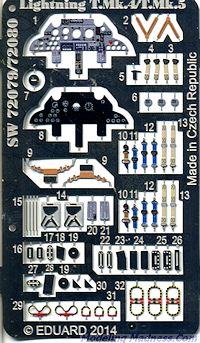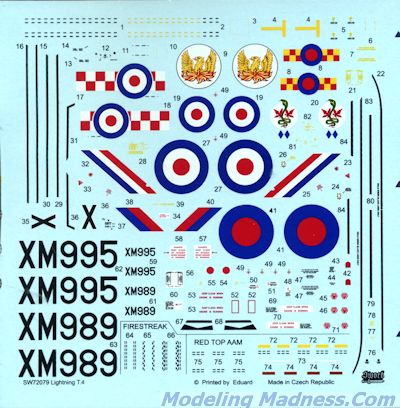
| KIT #: | SW 72079 |
| PRICE: | $38.99 SRP |
| DECALS: | Twoee options |
| REVIEWER: | Scott Van Aken |
| NOTES: | Short run with photo etch and resin parts |

| HISTORY |
The English Electric Lighting was Great Britain's last dedicated interceptor. As an interceptor, it was blindingly fast, but suffered from short range. Various methods were used to extend the range including a larger ventral fuel tank and over-wing 'drop' tanks. However, the most widely used method was air to air refueling.
Always a rather low production aircraft, 337 were built in six major variants, none in great numbers. A few were exported to Kuwait and Saudi Arabia. Many earlier planes were converted into later variants. Though retired in 1988/89, some were kept flying in South Africa until 2010 and several are kept for 'high speed taxi' demonstrations in the UK.
There were two trainer versions. The T.4 was based on the F.1A while the T.5, another two-seat side-by-side training version, was based on F.3. Two prototype T.4s and 20 production aircraft built, two aircraft later converted to T.5 prototypes, two aircraft later converted to T.54. These trainers were combat capable, armed with Firestreak missiles, though rarely carried them or even the training rounds.
| THE KIT |
 Sword
has finally come to the rescue with two Lighting trainers. Prior to this
there was only the Matchbox T.54 and the Aeroclub conversion for use with
the Airfix F.1 kit.
Sword
has finally come to the rescue with two Lighting trainers. Prior to this
there was only the Matchbox T.54 and the Aeroclub conversion for use with
the Airfix F.1 kit.  Resin
is used for three items; the two seats, the exhaust section, and while a
resin cockpit tub is shown in the instructions, there is none in the kit. An
extensive photo etch set is part of the kit. This is done by Eduard and is
in color. It includes a lot of parts for the seats, including the harness,
as well as for the interior. Many of the parts are used for the outside of
the fuselage and that includes a plethora of antennas, each with separate
and tiny bases. This will be enough to drive several to drink.
Resin
is used for three items; the two seats, the exhaust section, and while a
resin cockpit tub is shown in the instructions, there is none in the kit. An
extensive photo etch set is part of the kit. This is done by Eduard and is
in color. It includes a lot of parts for the seats, including the harness,
as well as for the interior. Many of the parts are used for the outside of
the fuselage and that includes a plethora of antennas, each with separate
and tiny bases. This will be enough to drive several to drink.  For armament, you have a choice of two
Firestreak, which this version carried or Red Top, which were valid with the
F.3/6 versions. These missiles have separate fins and you also can do training rounds, which are made by leaving off the main fins. The
windscreen and canopy are separate so that you can pose the canopy in the
open position.
For armament, you have a choice of two
Firestreak, which this version carried or Red Top, which were valid with the
F.3/6 versions. These missiles have separate fins and you also can do training rounds, which are made by leaving off the main fins. The
windscreen and canopy are separate so that you can pose the canopy in the
open position.  he
other is with 92 Squadron with a dark green upper surface. Note that the
engine inlet ring was generally polished, often to a very bright shine. The decals are very nicely done and
provide a full stencil suite. This includes the very prominent wing walk
stripes in both black and white. Missile markings are also given. Pretty
much every unit plust the OCU and the LTF flew two seat versions, so I'll
bet there will be at least one aftermarket decal sheet for this one.
he
other is with 92 Squadron with a dark green upper surface. Note that the
engine inlet ring was generally polished, often to a very bright shine. The decals are very nicely done and
provide a full stencil suite. This includes the very prominent wing walk
stripes in both black and white. Missile markings are also given. Pretty
much every unit plust the OCU and the LTF flew two seat versions, so I'll
bet there will be at least one aftermarket decal sheet for this one. | CONCLUSIONS |
If you are a Lighting fan, then this one really does have to be included into your collection. It will take a bit more effort than the usual Tamiya kit, but the result is well worth the additional work and you know Tamiya would not do it!
| REFERENCES |
http://en.wikipedia.org/wiki/English_Electric_Lightning
October 2014
Thanks to me for picking this one up when it was on sale.
If you would like your product reviewed fairly and quickly, please contact the editor or see other details in the Note to Contributors.